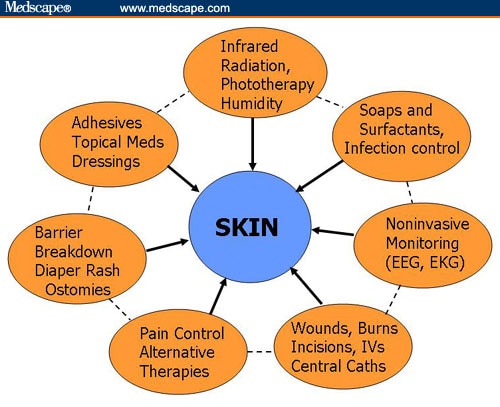Rethinking Vernix
Many people view vernix, like blood, meconium, or amniotic fluid, as one of the soils of the birth process that should be removed as thoroughly as possible after birth. Some babies have an abundance of vernix -- in every crack and crevice -- and quite a lot of energy is expended to present the parents with a clean newborn baby. The myth about why babies have vernix -- as a sort of "grease" to facilitate the birth process -- doesn't really make sense, given that the largest, term infants seem to have the least amount of the stuff.
Dr. Hoath and his colleagues at the Skin Sciences Institute, Cincinnati Children's Hospital Medical Center, have been studying the composition and properties of vernix and its role in adaptation of the neonate to the extrauterine, or dry, environment. Their research suggests that rather than being a soil, vernix is a natural skin cleanser. It may also be an anti-infective, an anti-oxidant, a moisturizer, and a wound-healing agent. Perhaps instead of rubbing vernix off of the newborn infant's skin, we should be rubbing it in![2]
The Biology of Vernix
Vernix caseosa is unique to humans. Structurally, it is similar to the outermost layer of the epidermis, the stratum corneum. Vernix is made up of hydrated fetal corneocytes embedded in a rich lipid matrix. It is the ability of these corneocytes to hold a large volume of water that gives vernix its water-retentive properties.
Vernix is synthesized during the last trimester of pregnancy. At that time, a surge in sebaceous gland activity and increased desquamation of fetal corneocytes combine to create a proteolipid film that covers the fetal skin surface during the critical period of adaptation before birth.[3]
Vernix is believed to interact with the developing epidermis and facilitate the in utero formation of the stratum corneum.[4] By covering the developing stratum corneum and waterproofing its surface, vernix allows cornification of the skin to occur. With advancing gestational age, vernix on the skin surface detaches into the surrounding amniotic fluid.[3] Evidence suggests that pulmonary surfactant produced by the fetal lung has a role in detaching vernix from the skin surface.[3] The detached vernix mixes with the amniotic fluid, causing turbidity of the fluid, a recognized marker of lung maturity.

Figure 1. External variables affecting newborn skin.
No comments:
Post a Comment